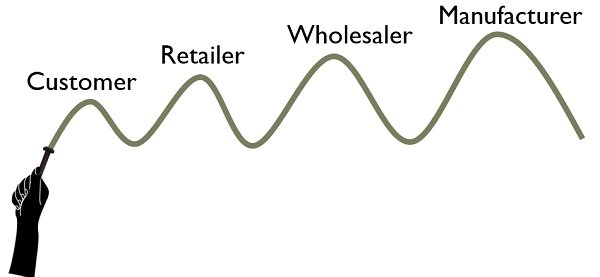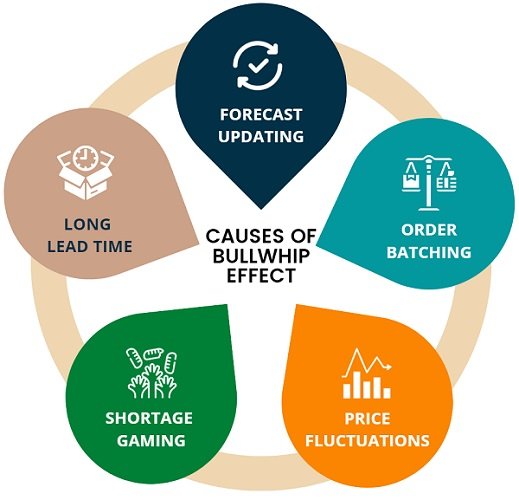Definition: The bullwhip effect is a concept of supply chain management. It explains how minute fluctuations in demand at the retail end can result in a very large fluctuation in demand at the wholesaler, manufacturer and supplier end. It is an internal (firm) response to external (environmental) stimuli.
A bullwhip effect takes place when retailers react actively to the momentary increase in demand, which in turn augments the expectations of other parties to the supply chain management.
This occurs when a retailer changes the quantity of goods it orders, usually from the wholesalers, depending on a small change in actual or forecasted demand. Further, as the wholesaler does not have complete information on the sudden increase in demand, the wholesaler will increase the quantity of orders to a larger extent.
Consequently, to achieve economies of large-scale production, the manufacturer will increase the scale of production by a comparatively larger extent.
The negative thing about the bullwhip effect is that it intensifies the inefficiencies in a supply chain at each stage and estimates the demand incorrectly.
Do you know?
The concept was introduced by Jay Forrester in Industrial Dynamics in the year 1961. And so it is also known as Forrester Effect.
Concept
Suppose a person holds a long whip in his hand, and as he gives a slight nudge to the whip, it forms small wavy movements in the parts which are close to the handle. However, the wave size is the largest at the end point of the whip.
In the same way, when it comes to the supply chain, the customers hold the whip. And when there is a slight movement in their demand, which moves up in the supply chain in an increasing pattern. Or we could say that as we move away from the customer, you will notice a bigger change in the demand.
If there is a spike in demand for the product, and so at each stage of the supply chain, there will be the addition of extra products to act as a buffer. So, if the retailer does this, it is the need of the hour because it ensures the in-stock products. However, when other parties in the supply chain also increase their order quantity, it results in overstocking. Moreover, the product may get out-of-stock later.
If the fluctuations in the customer’s demand are not rightly conveyed or if it is misinterpreted, as it moves upstream in the supply chain. It will result in overstocking or stock-out situations. This is what we call the ‘bullwhip effect‘. The effect of volatility in demand waves up the supply chain, leading to inventory problems.
This occurs due to the absence of smooth, right and quick information flow that leads to unsystematic coordination and synchronization of actions of supply chain partners. This issue is critical in those supply chains where there is low communication between the nodes.
You can observe the bullwhip effect in the supply chain mainly due to the incorrect assessment of demand at different decision points in the supply chain.
Causes of Bullwhip Effect
- Forecast Updating: Many forecast updates by every entity in the chain results in significant distortions. Each chain member updates the forecast depending on orders received at their end rather than the item demanded by the final consumer.
- Order batching: Each chain member has his own economies of scale with regard to production and transportation that results in planning activities which in turn results in order batching.
- Price Fluctuations: Discounts, special offers or promotional offers often trigger forward buying, which fluctuates the demand. Further, frequent changes in prices influence the ordering pattern of the buyer.
- Shortage gaming: When there is a shortage, suppliers often take recourse to rationing, which motivates buyers to inflate orders.
- Long lead time: The time gap between order placement and receipt of the order is the lead time. When the lead time is long, it often increases the planning perspective of other parties. Consequently, each party to the supply chain keeps large amounts of safety stocks, which results in distortion.
Of all the causes listed above, updating of demand forecasts proves to be the key source of the bullwhip effect.
The parties of the supply chain determine their forecast as per past demand trends of their customers. At the same time, the retailers make decisions on the basis of the actual demand pattern of the customers. Whereas the other parties simply adjust to the fluctuations in the ordering policies of the participants preceeding them in the SC.
So, when every participant reacts to the fluctuations in demand, it gets amplified.
How to Reduce Bullwhip Effect?
To overcome this issue, customers and suppliers should work in collaboration to improve the quality of information.
- Timely availability of information.
- Integration and coordination of various decision-making points in the supply chain
- Making use of information technology for managing information analysis and its flow.
- Decreasing the demand variance upstream in the supply chain.
- Reducing the order size flexibility.
- Minimum price fluctuations
Most importantly, exchanging relevant information and keeping transparency is necessary at all levels for coping with the bullwhip effect.
Impact
- The bullwhip effect results in an increase in manufacturing cost, inventory cost, and transportation cost decrease in product availability and replenishment in the lead time.
- Excessive money is locked up in inventory throughout the supply chain.
- Poor customer service because some participants would encounter a shortage of products due to a lack of means to overcome variations in demand.
- Revenue loss because of shortages.
- The productivity of the capital invested in the operations becomes subpar.
A word from Business Jargons
The bullwhip effect reflects the growing severity of distortion relating to the demand information and ordering pattern as the information passes from one point of the supply chain to another.
The bullwhip effect usually generates unnecessary tension in the whole supply chain. Also, it is responsible for an unexpected surge in inventory or severe shortages.




Leave a Reply